1. Introduction
 Today we will be reviewing one of Asus' latest product releases, which fits in the "affordable" products category, and is Asus answer to currently available mid-end graphics cards on the market. The EAX1300PRO is a PCI-E interface card, based on an ATI Radeon enabled chipset that is geared towards the not so demanding users who prefer to pay a small fee for an increase in their gaming performance.
Today we will be reviewing one of Asus' latest product releases, which fits in the "affordable" products category, and is Asus answer to currently available mid-end graphics cards on the market. The EAX1300PRO is a PCI-E interface card, based on an ATI Radeon enabled chipset that is geared towards the not so demanding users who prefer to pay a small fee for an increase in their gaming performance.
Having said that, let us start off with this review by checking the packaged bundle.
- Packaging/Bundle

Not as fancy as other releases, the X1300PRO package is of simple design, as is the case with all "light weight" cards, but still showcases all the usual logos at bottom centre of the box. The card being a "light version", is also reflected in the bundled software, where we find the following:

• The Asus EAX1300PRO card
• 1x DVI/CRT converter
• Asus Multilingual Manual
• Asus VGA Driver, Including : WDM Driver 1.0.0.1, Microsoft DirectX 9.0c, Asus Enhanced Driver 1.21, Asus Video Security Online 3.5.0.0, Asus GameLiveShow 1.21, Asus GameFace Messenger 2.1
As we see, there's nothing fancy or extravagant about the package and it probably won't influence the decision of a potential buyer, at least not by its looks. So, let's move on to the specifications for the card itself...
2. Specifications
Specifications

The EAX1300PRO is equipped with the ATI RADEON X1300PRO GPU which is, as Asus describes, derived from the ATI X1800 GPU, thus sharing many of its capabilities and features. The card is equipped with 256MB DDR2 Video Memory and uses the latest PCI-E interface to comply with the motherboard. Its Core and Memory Clocks are set to 600MHz and 800MHz (400MHz DDR2) respectively and is equipped with the standard DVI output, though a VGA output is possible, with the use of a DVI to VGA adaptor included in the bundle.
Here are the specs for the graphics card, as seen on the ASUS website...

Below we can see the card's specs as reported by the ATI Catalyst utility...



Features
The card supports some of the Asus exclusive features, listed below:
 |
Easy IM and live game conference in any PC games |
 |
Stream live gaming action onto the internet and share with other gaming enthusiast |
 |
Recording gaming action and strategy into MPEG4 files to share with other gaming enthusiast |
 |
OSD allows you to instantly adjust various display settings in almost any PC game without leaving the game. |
 |
Watching movies on PC is as good as on Top-of-the-line consumer television |
 |
Provides three ways of dynamic overclocking to push your ASUS VGA card to the limit. |
 |
Whether you're online or not, ASUS VideoSecurity Online provides you a flexible and economical security system. It can easily turn your computer into your own security server. |
These are the basic features of the graphics card, as found on Asus' website and the package. The graphics card is a mid-range standards card, without any expert features or capabilities, equipped only with the necessities to perform to perform the point it is as meant to, and no further.
Throughout this review, we will be comparing the X1300PRO with two other cards, one being of similar performance and one with higher standards, for comparison reasons.
3. A Closer Look
This page lists available information about a card, such as design, heatsink, fan, voltage and memory cooling among others. In this review, we will not discuss in depth the graphics card's architecture.
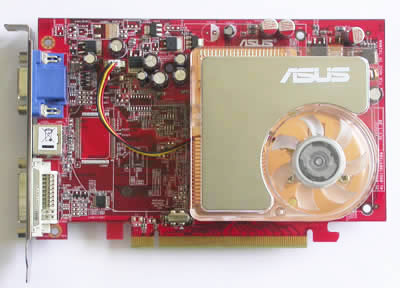 |
A small cooling fan system occupies the 50% of the cards surface... |
Four screws hold the heatsink in place, while no cooling is provided for the memory chipsets on the back of the pcb, as can be seen in the picture below...
 |
Light design in this case too... |
A close up of the memory modules reveals that the modules are the Hynix series, clocked at 400MHz (800MHz effective as stated in the card's specs)...
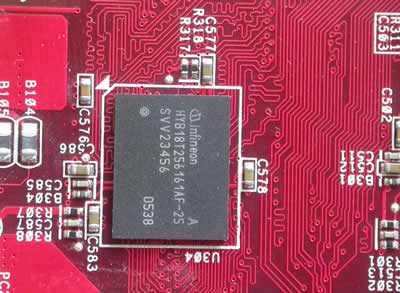 |
Hynix memory modules... |
Last but not least, the card offers a VGA out connector, a Video Out connector and a DVI connector...

This concludes a close-up look of the graphics card. Let us move on to the tests and testbed.
4. Test System
For our review, we setup the following testbed:
Processor: AMD64 3500+ NewCastle (939 socket)
Case: Antec 1080AMG
Motherboard: MSI
Memory: 2x512MB Corsair XMS TWINX1024-3200XL Memory
Hard Disk Drive: WD800JD 80GB 7200RPM
DVD Burner: Pioneer DVR-A08XLA
Power Supply: EzCool 550Watt
OS: Microsoft WindowsXP Pro SP2
DirectX: v9.0c

Benchmarking Software
3DMark05,03,01
Codecreatures Benchmark Pro
AquaMark3 v3.0
ATITool
Farcry v1.3
HL2
Quake 4
Need for Speed Most Wanted
Ground Control II
F.E.A.R.
5. 3DMark2005
 With 3DMark05, Futuremark continues the tradition in its benchmarking software by providing a state-of-the-art Microsoft ® DirectX ® 9 3D performance benchmark.
3DMark05 is an all new 3DMark version making the most of Microsoft's DirectX
9. The previous version 3DMark03, did a nice introduction into this level
of technology. However
3DMark03 used DirectX 9 specific features in a limited manner, because fully
supporting hardware was rare at the time of its launch. In contrast, 3DMark05
requires DirectX 9 hardware with full support for at least Shader Model 2,
and takes shader usage to never before seen levels.
With 3DMark05, Futuremark continues the tradition in its benchmarking software by providing a state-of-the-art Microsoft ® DirectX ® 9 3D performance benchmark.
3DMark05 is an all new 3DMark version making the most of Microsoft's DirectX
9. The previous version 3DMark03, did a nice introduction into this level
of technology. However
3DMark03 used DirectX 9 specific features in a limited manner, because fully
supporting hardware was rare at the time of its launch. In contrast, 3DMark05
requires DirectX 9 hardware with full support for at least Shader Model 2,
and takes shader usage to never before seen levels.
Just like its predecessors, 3DMark05's point system is set so that at the
moment of release, the high-end VGA cards available in stores can only score
around 5000 3DMarks, whereas the worst card that meets the programs requirements
yields a score of 1000.
Game Test 1 -Return to Proxycon
 Being the sequel to the "Battle of Proxycon"
from 3DMark03, in "Return to Proxycon" we're once again set in space
and the battle continues as space pirates invade a cargo ship in order to
take control of its valuable cargo.
Being the sequel to the "Battle of Proxycon"
from 3DMark03, in "Return to Proxycon" we're once again set in space
and the battle continues as space pirates invade a cargo ship in order to
take control of its valuable cargo.
This test, tries to simulate a future first-person shooter game with all the high details that entails. The dynamic shadows, high-detailed environment and advanced lighting techniques ensure that under normal circumstances, no recent card can run it with decent frame rates.
Game Test 2 - Firefly Forest
 A forest gets filled with magic fireflies in the night. The moon is nearly full, illuminating the forest with a bluish faint light. The magic fireflies have flickering bright green lights that playfully move around the forest.
A forest gets filled with magic fireflies in the night. The moon is nearly full, illuminating the forest with a bluish faint light. The magic fireflies have flickering bright green lights that playfully move around the forest.
This scene is a nice example of a smaller scale outdoor scene with rich vegetation. Immediate visibility is not so far, and there is a skybox surrounding the whole scene.
A large number of trees with their branches swinging separately, and dense vegetation being dynamically distributed according to the camera movements, make this test the most demanding of the three.
Game Test 3 - Canyon Flight
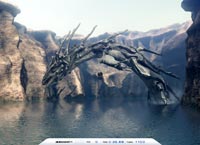 A Jules Verne type airship flies through a canyon guarded
by a dangerous sea monster. The airmen defend their ship using heavy cannons,
but these seem to have no effect on the huge sea monster. Finally the crew
manages a narrow escape using the "last resort" afterburners of
the airship.
A Jules Verne type airship flies through a canyon guarded
by a dangerous sea monster. The airmen defend their ship using heavy cannons,
but these seem to have no effect on the huge sea monster. Finally the crew
manages a narrow escape using the "last resort" afterburners of
the airship.
This scene is fairly complex with large areas of water
reflecting the high canyon walls. The water actually is one of the key points
of interest in this scene. The water not only does realistic looking reflections
and refractions, it has a depth fog, making the sea monster swimming under
the airship actually look deep down in the water. The air in this scene also
uses a volumetric fog, making distant cliffs of the canyon really look far
away.
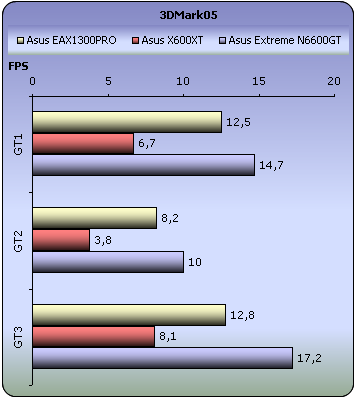
The reviewed card reported good results, compared to the previous generation graphics card (Asus X600XT) and not far behind the N6600GT which is a more technologically advanced card.
Final Score
3DMarks on 3DMark05 are now calculated by the following formula:
(Game Test 1 * Game Test 2 * Game Test 3)^0.33 * 250
That's basically the geometric mean of the total frames in each
game multiplied by 250. This means that all game tests are now equal.

According to 3DMark05, the reviewed card is a good performer, always in comparison to the previous generation card (X600XT). Never the less, the card is obviously not meant for high end performance, as the 2735marks is pretty low.
6. 3DMark2003
 3D Mark is a widely used and accepted benchmark that stresses the DirectX performance of a VGA card. A very strong point of 3DMark is that it's VGA card measuring is does not require any CPU power. So the resulting fps are a good reference a VGA card's rendering performance. For testing the performance of each card we used the 4 game benchmarks 3DMark has.
3D Mark is a widely used and accepted benchmark that stresses the DirectX performance of a VGA card. A very strong point of 3DMark is that it's VGA card measuring is does not require any CPU power. So the resulting fps are a good reference a VGA card's rendering performance. For testing the performance of each card we used the 4 game benchmarks 3DMark has.
3Dmark03 also includes sound and CPU tests as well as some other feature tests.
- Game Test 1 - Wings of Fury (DX7)
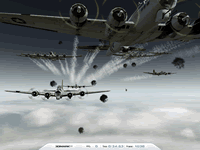
This test is a combat flight simulator written for older hardware (DirectX 7). Particles are used a lot in this test - smoke and vapor trails, flak and gunfire, and explosions are produced using point sprites and quads.
- Game Test 2 - Battle of Proxycon (DX8)

This test is a simulation of first person shooter game types. 1.1 and 1.4 Vertex shaders are widely used since all character models are skinned using vertex shaders.This makes this test a good vertex shader comparison for VGA cards.
- Game Test 3 - Trolls' Lair (DX8)
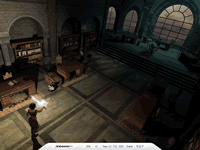
This test should be the favorite of all RPG lovers. It is a cut scene of a female warrior facing two malicious trolls. Again the same vertex and pixel processing is used as in game test 2.
This test also uses post-processing effects, such as Depth of Field and Bloom effects which are widely used in today's game cut scene sequences.
- Game Test 4 - Mother Nature (DX9)

Mother nature represents the level of effects and realism that are possible using 2.0 vertex and pixel shaders, plus some other features that DirectX 9 offers.
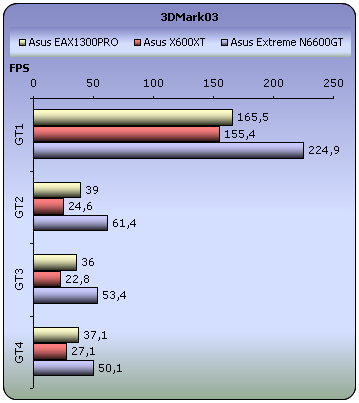
In GT1, all cards performed well, with the X1300PRO performing slightly better than the X600XT. The rest of the tests proved to be quite a handful for all three cards, but the outcome was still acceptable, with an average framerate of around 38fps in all three tests for the reviewed card.
- 3DMark Official score
If you test your machine with 3DMark, you can post the results at 3DMark's online result browser. For more information visit futuremark.com.
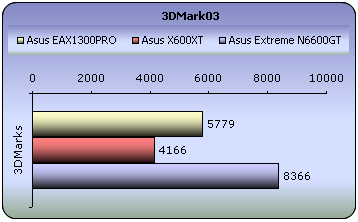
The X1300PRO card performed quite well, with a significant difference from the X600XT.
7. Codecreatures
 CodeCreatures is a synthetic 3D benchmark that is a good reference for VGA performance comparison. This is a high-end 3D benchmark that also requires DirectX 8 hardware, making a good tool for measuring the potential of DirectX 8 game performance.
CodeCreatures is a synthetic 3D benchmark that is a good reference for VGA performance comparison. This is a high-end 3D benchmark that also requires DirectX 8 hardware, making a good tool for measuring the potential of DirectX 8 game performance.
The Codecreatures benchmark is written with Microsoft's DirectX 8.1 API and incorporates the use of Vertex and PixelShaders popular on next generation 3D accelerators.

The benchmark plays a photo-realistic nature scene and calculates the performance of the graphics adapter by measuring the fps that it can display at 1024x768, 1280x1024 and 1600x1200 resolutions.

This test may be considered outdated, but it suits our needs for this review, since we are testing a mid-level graphics card. As can be seen in the above graph, the X1300PRO managed to produce some good results at all resolutions, and reporting an average of 23fps at the max resolution of 1600X1200.
-Codecreatures number
The codecreatures number is the resulting score of the total
benchmarking process and is basically the geometric mean of the three frame
rates multiplied by 100.

Once more, the X1300PRO graph card managed to achieve a much better score than the X600XT. Surely, a good upgrade choice for owners of previous generation mid level cards...
8. Aquamark - 3DMark01
 Since the majority of today's applications and games are compatible with DirectX 9, the need of benchmark applications that use DX 9 has been brought up. The benchmark uses the 3D engine (Krass engine) of the Aquanox game.
Since the majority of today's applications and games are compatible with DirectX 9, the need of benchmark applications that use DX 9 has been brought up. The benchmark uses the 3D engine (Krass engine) of the Aquanox game.
- Aquamark Triscore
The Aquamark Triscore comprises 3 values: the overall system performance, the performance of the graphics system and the CPU performance. Keep in mind that this is not the total result of the tests, but the result of the whole benchmark process including all 9 chapters.
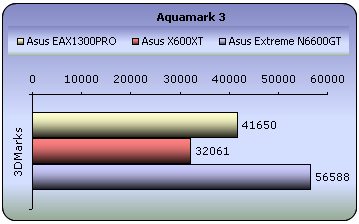
The results are similar to those of all the previous tests, with the reviewed card being better than the X600XT.
- 3DMark 2001
 is the predecessor to 3DMark03. It's mainly a directx8.1 benchmark and the score depends a lot on the CPU power of your computer. However for reference use only we decided it'd be best to just leave it in our benchmark list so you can compare the next generation cards with the possibly outdated you have at home.
is the predecessor to 3DMark03. It's mainly a directx8.1 benchmark and the score depends a lot on the CPU power of your computer. However for reference use only we decided it'd be best to just leave it in our benchmark list so you can compare the next generation cards with the possibly outdated you have at home.
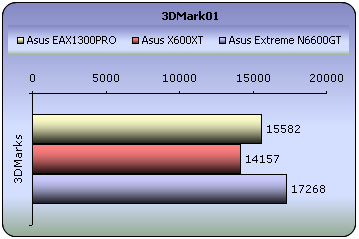
Nothing to add here. Again the X1300PRO out-performed the X600XT.
9. F.E.A.R.
 You aren't a soldier. You are a weapon. A paramilitary force infiltrates a multi billion dollar aerospace compound taking hostages, but issuing no demands.
You aren't a soldier. You are a weapon. A paramilitary force infiltrates a multi billion dollar aerospace compound taking hostages, but issuing no demands.
The government responds by sending in its best special operations teams, only to have them obliterated. Live footage of the massacre is cut short by an unexpected wave of destruction that leaves military leaders stunned and in disbelief.
First Encounter Assault Recon (F.E.A.R.) is one of the new-generation FPS. The graphics are really stunning, the plot behind the whole shooting successfully keeps it interesting and even the A.I. seems to work out well.
F.E.A.R. offers a lot to the First Person Shooter world. The graphics are very clear with excellent textures, great new effects that will stress your graphics card and ragdoll physics that are waiting to be exploited as you progress through the game.
- Benchmark Settings
F.E.A.R. allows you test the video settings on a mini-benchmark involving a lot of weapon firing, explosions and several other effects. After the benchmark is run you're presented with a screen showing your minimum, average and maximum framerate and also percentages of how often the framerate was below 25fps, between 25 and 40, and finally above 40. For presentation reasons we're just sticking to the minimum and average framerate.
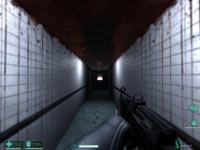
The resolutions we used are 800x600, 1024x768, 1280x1024 and 1600x1200. We measured performance with high and highest details.
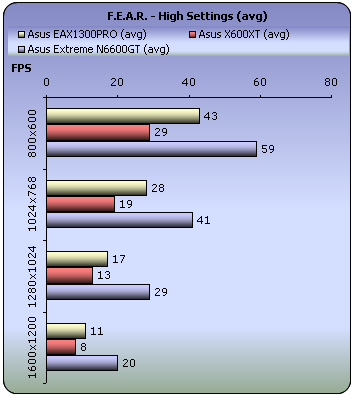
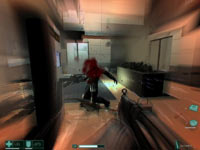

From what we can see of the above charts, the game stops being playable beyond a resolution of 800x600.

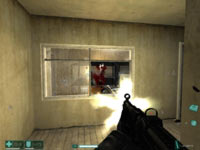
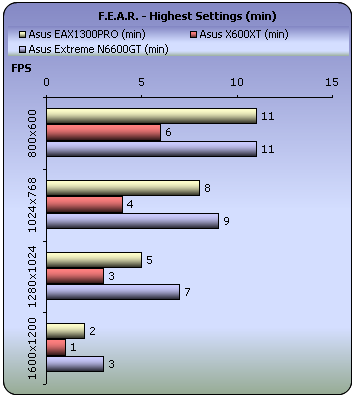
With the Highest settings enabled, the card cannot perform adequately so it is not recommended for such demanding games.
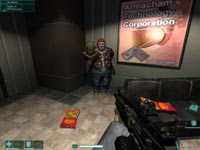
10. Need For Speed - Most Wanted
 Wake up to the smell of burnt asphalt as the thrill of illicit street racing permeates the air.
Wake up to the smell of burnt asphalt as the thrill of illicit street racing permeates the air.
Combining illicit street racing and tuner customization with the intensity of strategic police pursuit that surpasses any Hollywood-style chase scene, Need for Speed Most Wanted will be on every gamer's 'must-have' list this holiday season. Out-race rivals, evade cops and exploit hundreds of miles of open road as gamers make their way up the Blacklist.
To become the most wanted racer, players must build up their street cred and Rap Sheet with gripping, white knuckle, head-to-head races with the top drivers on the streets, as well as pull daring, evasive moves to out-run and out-fox the cops that patrol the open road. Players can manage their heat or utilize a number of strategic tactics to keep the cops off their tails as they leave their rivals behind to suck their exhaust fumes.

- Benchmark Settings
NFS Most Wanted includes no default benchmark. To measure the card's performance, we've chosen to record the framerate at the start of a circuit race with end-game cars. The starting point tends to be one of the most graphically demanding parts because of the smoke coming from spinning wheels added to the rest of the game's visual effects. If a card can pass this step with an acceptable framerate, it is guaranteed that it will face no problems with the rest of the game.

The resolutions we used are 800x600, 1024x768, 1280x1024 and 1600x1200. We measured performance at the lowest and highest possible settings.
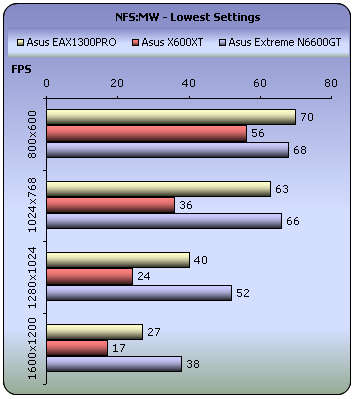
No problem at all with the lowest settings here. The game is playable at all resolutions, except for 1600x1200, where play was sometimes jerky.
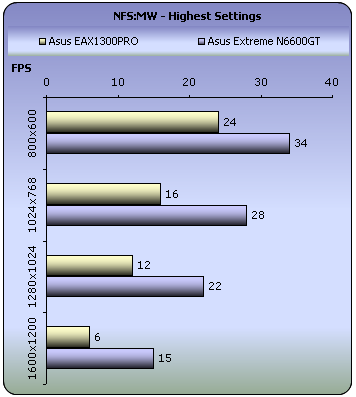
You'll notice the X600XT does not register. This is because the option of enabling some details such as Anti-Aliasing was not available. Alas, with the highest settings enabled, the game is unplayable, managing only a max of 24fps average at the lowest resolution.

11. Quake 4
 In a desperate war for Earth's survival, against an unrelenting alien enemy, the only way to defeat them is to become one of them. Armed with advanced weaponry and vehicles and aided by an elite squad of marines, you take the battle to the heart of the Strogg home planet and become Earth's only hope for victory.
In a desperate war for Earth's survival, against an unrelenting alien enemy, the only way to defeat them is to become one of them. Armed with advanced weaponry and vehicles and aided by an elite squad of marines, you take the battle to the heart of the Strogg home planet and become Earth's only hope for victory.
Quake 4 is a First Person Shooter developed by Ravensoft, based on the Doom 3 engine and the graphics and gameplay certainly reflect that fact. For those who really hated the one-way corridors of Doom 3, new outdoor areas have been added to the game, however the feeling still remains the same as these areas are quite small-scale, contrary to what other games have to offer.
- Benchmark Settings

As Quake 4 includes no default benchmark, we decided to go with another publicly available demo to measure performance. The one we chose is a demo made by HWSpirit which involves a small outdoor scene followed by a long indoor combat. As preloading the stage once again failed miserably and the average framerate varied a lot the second time we ran the demo, we ran it twice every time we restarted the game and measured only the second run.

The resolutions we used are 800x600, 1024x768, 1280x1024 and 1600x1200. We measured performance with and without Anti-aliasing.
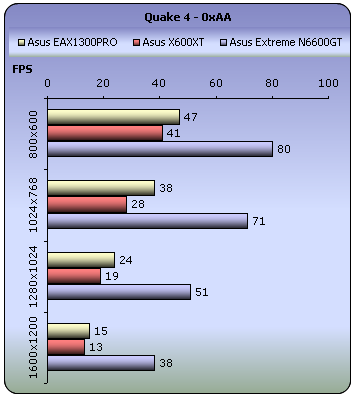
Even at 1024x768, the card performs well, offering a playable environment for the end user.
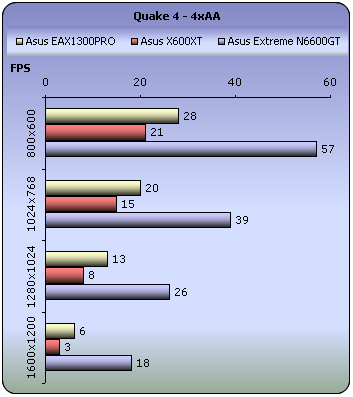
With Anti-aliasing and Anisotropic filtering, the card's performance is naturally a lot lower, and the card is hardly able to offer satisfactory performance, even at the lowest resolution.

12. Half Life 2

Half life 2 is no doubt the most anticipated pc game of all times. Gamers keeping the excellence of Half Life 1 in their mind as well as the remarkable E3 demo preview, have been anxiously waiting for the much delayed release of HL2.
 Characters - Advanced facial animation system delivers the most sophisticated in-game characters ever seen. With 40 distinct facial "muscles," human characters convey the full array of human emotion, and respond to the player with fluidity and intelligence.
Characters - Advanced facial animation system delivers the most sophisticated in-game characters ever seen. With 40 distinct facial "muscles," human characters convey the full array of human emotion, and respond to the player with fluidity and intelligence.
Physics - From pebbles to water to 2-ton trucks respond as expected, as they obey the laws of mass, friction, gravity, and buoyancy.
 Graphics
- Source's shader-based renderer, like the one used at Pixar to create movies
such as Toy Story® and Monster's, Inc.®, creates the most beautiful
and realistic environments ever seen in a video game.
Graphics
- Source's shader-based renderer, like the one used at Pixar to create movies
such as Toy Story® and Monster's, Inc.®, creates the most beautiful
and realistic environments ever seen in a video game.
AI - Neither friends nor enemies charge blindly into the fray. They can assess threats, navigate tricky terrain, and fashion weapons from whatever is at hand.
To measure performance we used the Video Stress Test(VST) that is available in the CounterStrike:Source beta available through Steam. We set all the details to the highest level and each time changed the resolution from 800x600 up to 1600x1200.

Thanks to the HL2 graphics engine, all cards performed well, even at the highest available resolution. AA and AF are off.
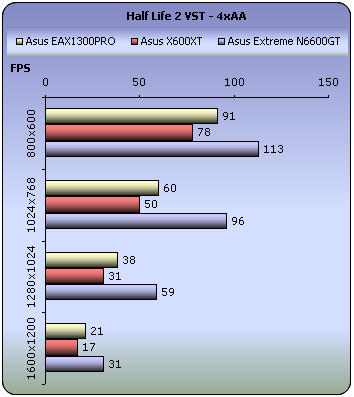
Enabling AA and AF, the performance drops to half, although the game remains playable even at 1280x1024 resolution.
13. Far Cry

 You are Jack Carver running your own boat charter business in beautiful Micronesia. With a past best left behind you, you'll be focusing on your present assignment: escorting an ambitious journalist named Valerie Cortez to the Island of Cabatu. It seems like a piece of cake, but you'll soon learn: paradise can be hell.
You are Jack Carver running your own boat charter business in beautiful Micronesia. With a past best left behind you, you'll be focusing on your present assignment: escorting an ambitious journalist named Valerie Cortez to the Island of Cabatu. It seems like a piece of cake, but you'll soon learn: paradise can be hell.
Farcry is an awesome First Person Shooter (FPS) based on a last generation 3D engine named as CryEngine. Real-time editing, bump-mapping, static lights, network system, integrated physics system, shaders, shadows and a dynamic music system are just some of the state of-the-art features that the CryEngine offers.
A great advantage and strong point of the CryEngine is its physics system which supports character inverse kinematics, vehicles, rigid bodies, liquid, rag doll, cloth and body effects. All physics seem to be very realistic and you never get bored when facing enemies, since character models have multiple animations that blend in believable ways.
With an integrated shader system and a massive terrain which maximizes
the view distance to 2km, these features make Farcry a perfect action game and
also a referable benchmark to speak of.
- Benchmark Settings
For this game we recorded a custom demo from the start of the Rebellion
stage. We chose an indoor scene in order to avoid getting the CPU bound effect. This will result in slightly higher results since it is also less
GPU intensive, but we can't afford being stuck at 40-50 fps because of our CPU.

The latest patch (1.3) was used for our tests which updates the
game's graphics engine to use the 3.0 Shader model. This option is only supported
for the 6800 series.

The resolutions we ran the demo under, are the following: 800X600, 1024X768, 1280X1024 and 1600X1200.
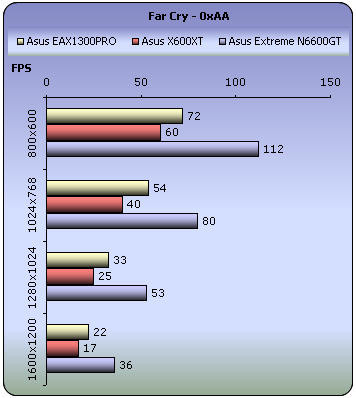
The game is playable, with the X1300PRO delivering an average of 33fps at 1280x1024 resolution.
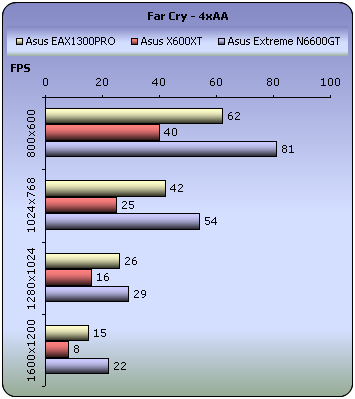
The card managed to run the game relatively smoothly, delivering an average of 42fps at 1024x768.
14. Ground Control II
 Ground
Control 2 is an action-oriented game of tactics and warfare. As Captain Jacob
Angelus of the Northern Star Alliance, you will command squads of infantry,
artillery, and air power against the might of the Empire of Terra. Base building
and resource-collecting are replaced with unit control and combat tactics where
your knowledge of the battlefield maneuvers will make the difference in your
fight against a ruthless enemy. Position your troops on hilltops for better
aim or inside buildings and forests for protection as you'll need to use every
inch of terrain to your advantage.
Ground
Control 2 is an action-oriented game of tactics and warfare. As Captain Jacob
Angelus of the Northern Star Alliance, you will command squads of infantry,
artillery, and air power against the might of the Empire of Terra. Base building
and resource-collecting are replaced with unit control and combat tactics where
your knowledge of the battlefield maneuvers will make the difference in your
fight against a ruthless enemy. Position your troops on hilltops for better
aim or inside buildings and forests for protection as you'll need to use every
inch of terrain to your advantage.
For our benchmarks, we used the highest possible settings on the first mission
of the single player game and moved around the camera to get an average frame
rate using fraps.

Ground Control II offers really impressive graphics without requiring much GPU power. Click on the picture above to view a screenshot from the game. Check out these excellent water effects!
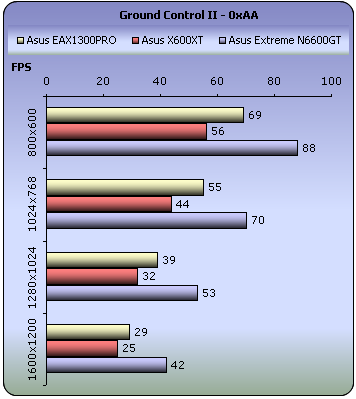
The card manages a good performance, reaching the limit of 30fps at the maximum available resolution.
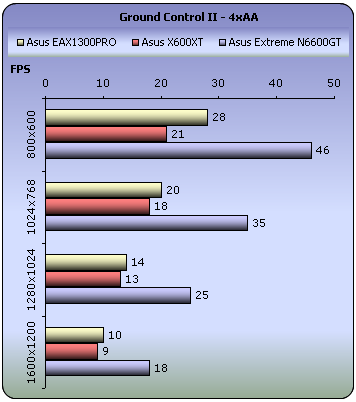
With AA and AF enabled, performance is severely reduced.
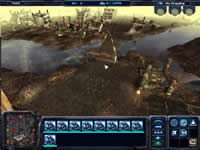
15. Overclocking
No matter your graphics card, there comes a time in your computer's life when it can no longer cope with the latest technology the ever so popular games use. This is one of the main reasons for overclocking your graphics card. Gamers are always looking forward for a little extra boost in terms of framerate. Even though most of the times the boost is far from noticeable, overclocking remains the last resort when you can't afford to buy a brand new VGA card.
 |
Increasing the memory clock too much,
produces the so-called "artifacts". |
The stock clock speeds for the ASUS EAX1300PRO were 600MHz for the core and 400MHz for the memory.
Firing up ATITool, we loaded the card's default speeds and started tweaking them.
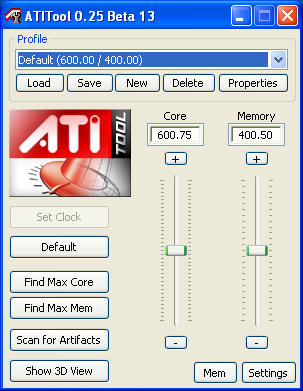
After a bit of tweaking and messing around with the core and memory clocks, we settled at a core speed of 660 and memory up to 450. Not much of an OC, but unfortunately the card could not give better results.

Let's see what difference that new settings can offer.
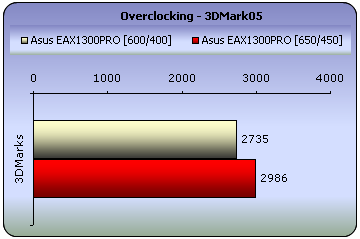
As we see above, due to the fact that the core and memory clocks could not be tweaked quite as high as we wanted, we have a small difference between the stock and OC version of the card. Overclocking is not necessary and wouldn't give significantly better results in any case.
16. Conclusion
Not all end users want, or at least are willing to spend a large amount of money just to play PC games at high resolutions and with extreme graphics settings. Since last Christmas, more than enough cards have been released that would please even the most demanding hardcore gamer. However, since gaming is not the only reason for having a graphics card, cards like the X1300PRO have hit the market, covering the needs of the non-hardcore gamers, who don't want to pay large amounts of money for the sake of extra performance. Throughout these pages, we've looked at how a mid-level graphics card performed with our suite of tests. From what we've seen, we can safely say this: the X1300PRO offers more than enough pixel power, to please the not so demanding users.

By "mid-level performance", we mean that the card is capable of running all the latest 3D applications (games) without having to turn off all the graphics settings. In most cases, the card performed surprisingly well, managing to run games at 1024x768 resolution with some "heavy" settings enabled, while still reporting in a decent framerate. Do not expect to play F.E.A.R with full AA/AF, but then again NFS:MW, one of the most popular racing games out there is playable, and at a reasonable resolution. Note here, that the X1300PRO surpasses some previous generation mid-level graphics solutions, and definitely qualifies as an upgrade choice for the owners of previous gen cards.
Overclocking is not an option here. The card managed to OC by 60/50Mhz for the core and memory clocks respectively, without returning a performance increase worth the trouble.The card is better off left at its default speeds, rather than risking running it at its limits without significant performance improvements.
Last but not least, the ASUS EAX1300PRO can be found at a price of US$97 from newegg.com.
Pros:
Good performance for a mid-level graphic card.
Cons:
No OC flexibility
| Performance: |
 |
| Overclocking: |
 |
| Bundle: |
 |
| Value for money: |
 |